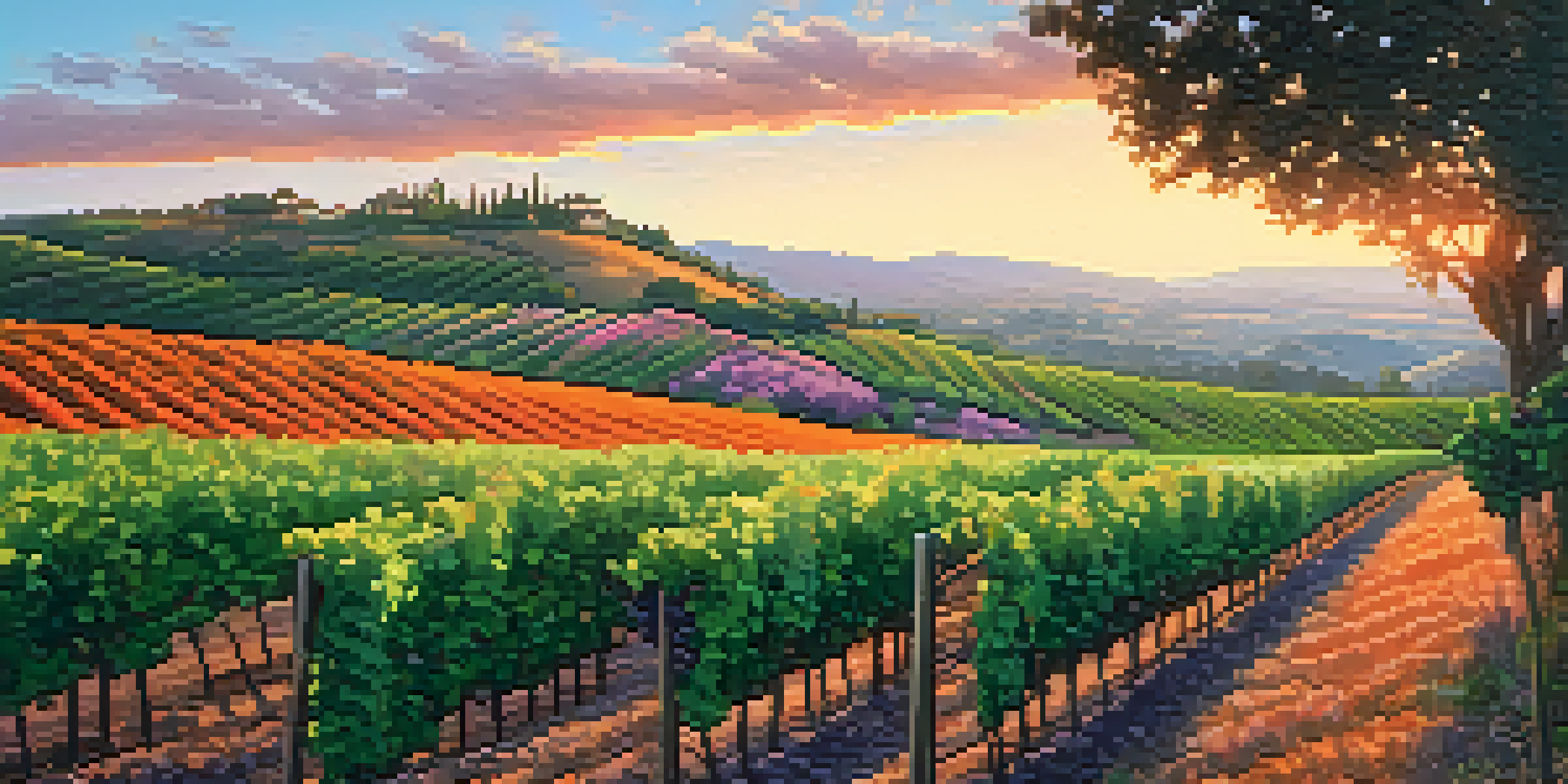Sonoma County's Diverse Viticulture: A Deep Dive

A Brief Overview of Sonoma County's Wine Regions
Sonoma County is renowned for its diverse climates and terrains, making it a haven for viticulture. With over 18 different American Viticultural Areas (AVAs), this region is home to a variety of grape types. Each AVA offers unique growing conditions, from the coastal influence of the Sonoma Coast to the warmer inland valleys. This diversity not only enhances the quality of the wines produced but also enriches the overall wine-tasting experience for visitors.
Wine is sunlight, held together by water.
The geographical variety within Sonoma County means that winemakers can experiment with numerous varietals, resulting in a rich tapestry of flavors. For instance, the Russian River Valley is celebrated for its Pinot Noir and Chardonnay, while the Dry Creek Valley is known for its bold Zinfandel. This interplay of geography and climate creates a dynamic landscape where each sip of wine tells a story of its origin.
Moreover, Sonoma County's commitment to sustainable farming practices further amplifies its appeal. Many vineyards here prioritize organic and biodynamic methods, ensuring that the land remains healthy and vibrant for future generations. This dedication to sustainability not only enhances the quality of the grapes but also resonates with environmentally-conscious consumers.
The Role of Climate in Wine Production
Climate plays a pivotal role in shaping the characteristics of wines produced in Sonoma County. The region experiences a Mediterranean climate, which is ideal for grape cultivation. Coastal breezes help to moderate temperatures, allowing grapes to ripen slowly and develop complex flavors. This climate variability is key to producing high-quality wines that capture the essence of the land.

Seasonal changes bring about distinct growing phases, influencing the harvest and flavor profiles of the grapes. For example, the cool nights help preserve acidity, crucial for white wines and certain reds. In contrast, warmer days promote the ripening of the fruit, allowing for the development of robust flavors. This balance between warmth and coolness is what makes Sonoma wines so unique.
Diverse Wine Regions Enhance Quality
Sonoma County's 18 American Viticultural Areas (AVAs) provide unique climates and soils, allowing a wide variety of grape types and flavors.
Additionally, the microclimates within the various AVAs contribute further to the complexity of the wines. A vineyard might be just a few miles from another but experience entirely different weather patterns. This is why Sonoma County is often described as a patchwork quilt of terroirs, each contributing to the diverse offerings found in local wineries.
Exploring Key Grape Varietals in Sonoma County
Sonoma County is a playground for wine enthusiasts, showcasing a wide array of grape varietals. Among the most popular are Cabernet Sauvignon, Chardonnay, and Pinot Noir, each thriving in specific AVAs. For instance, Cabernet Sauvignon flourishes in the warmer Dry Creek Valley, producing wines that are rich and full-bodied. Conversely, the cooler climates of the Russian River Valley are ideal for crafting elegant Pinot Noir.
The best wines are the ones we drink with friends.
Additionally, lesser-known varietals are also making waves, such as Grenache and Syrah, which are gaining traction among local winemakers. These grapes offer exciting new flavor profiles that intrigue both novice and seasoned wine drinkers alike. The experimentation with different varietals reflects the innovative spirit of Sonoma’s winemakers, who are always eager to explore new possibilities.
This diversity in grape varietals not only caters to a range of palates but also ensures that there is something for everyone. Whether you prefer the robust flavors of a red or the crispness of a white, Sonoma County's vineyards have you covered. Each glass of wine reveals a unique story, influenced by the varietal, the region, and the winemaker's vision.
The Influence of Winemaking Techniques
Winemaking in Sonoma County is as diverse as the grapes themselves, with various techniques employed to enhance the final product. Traditional methods, such as barrel aging, are often combined with modern technology to create wines that are both classic and innovative. For example, winemakers might use French oak barrels to impart subtle flavors while monitoring fermentation temperatures to maintain fruit integrity.
Additionally, some wineries embrace natural winemaking processes, allowing wild yeasts to ferment the grapes. This technique can lead to wines with unique, complex flavors that reflect the vineyard’s terroir. Such practices highlight the creativity and passion of Sonoma’s winemakers, who are constantly pushing the boundaries of what wine can be.
Sustainability Shapes Winemaking
Many vineyards in Sonoma County prioritize sustainable farming practices, enhancing grape quality and appealing to environmentally-conscious consumers.
The choice of winemaking technique also impacts the wine's character and aging potential. Techniques like carbonic maceration can produce lighter, fruit-forward reds, while more traditional methods yield structured wines suitable for aging. This variety ensures that wine lovers can find something that suits their taste preferences, making each visit to Sonoma an exciting adventure.
Sustainable Practices in Sonoma's Vineyards
Sustainability is at the forefront of Sonoma County's viticulture, with many vineyards adopting eco-friendly practices. From organic farming to water conservation, these methods aim to preserve the land while producing high-quality wines. By minimizing chemical use and maximizing biodiversity, winemakers are not only protecting the environment but also enhancing the health of their vineyards.
Many wineries participate in certification programs that promote sustainable practices, ensuring that consumers can make informed choices. These certifications often include guidelines for soil health, pest management, and energy efficiency. This commitment to sustainability resonates with a growing number of consumers who are seeking wines that align with their values.
Moreover, sustainable practices often improve the quality of the grapes, leading to better wines. Healthier vines produce fruit that is more expressive of the terroir, allowing winemakers to create wines that truly reflect the essence of Sonoma County. This holistic approach to viticulture not only benefits the environment but also elevates the wine experience for everyone.
Wine Tourism: A Thriving Industry in Sonoma
Sonoma County's reputation for exceptional wines has made it a prime destination for wine tourism. Visitors flock to the region to explore its picturesque vineyards, participate in tastings, and enjoy the stunning landscapes. The combination of beautiful scenery and world-class wines creates an irresistible allure for travelers seeking a memorable experience.
In addition to wine tastings, many wineries offer tours, events, and culinary experiences that showcase the local gastronomy. From farm-to-table dining to wine-pairing dinners, there is something to satisfy every palate. This focus on experiential offerings allows visitors to immerse themselves in the culture of Sonoma County, creating lasting memories.
Wine Tourism Boosts Local Economy
The popularity of wine tourism in Sonoma County attracts visitors to its scenic vineyards and experiences, benefiting local businesses and communities.
Furthermore, wine tourism contributes significantly to the local economy, supporting businesses and jobs in the area. As more people discover the charm of Sonoma, the region continues to grow in popularity, further solidifying its place as a premier wine destination. It’s a win-win situation: travelers enjoy unforgettable experiences, while local communities thrive.
The Future of Sonoma County's Viticulture
As Sonoma County's viticulture continues to evolve, the future looks bright for this iconic wine region. With ongoing innovations in winemaking and a commitment to sustainability, the area is poised to remain a leader in the industry. New technologies and practices are being explored, allowing winemakers to adapt to changing climates and consumer preferences.
Additionally, as the global wine market grows, Sonoma County is gaining recognition both nationally and internationally. The region's diverse offerings are attracting attention from wine lovers around the world, leading to increased demand. This recognition not only benefits local wineries but also enhances the overall reputation of Sonoma County as a premier wine destination.

Ultimately, the future of Sonoma County's viticulture will depend on the dedication of its winemakers and the continued support of the community. By embracing innovation while honoring tradition, Sonoma County is set to thrive as a vibrant and diverse wine region for generations to come.